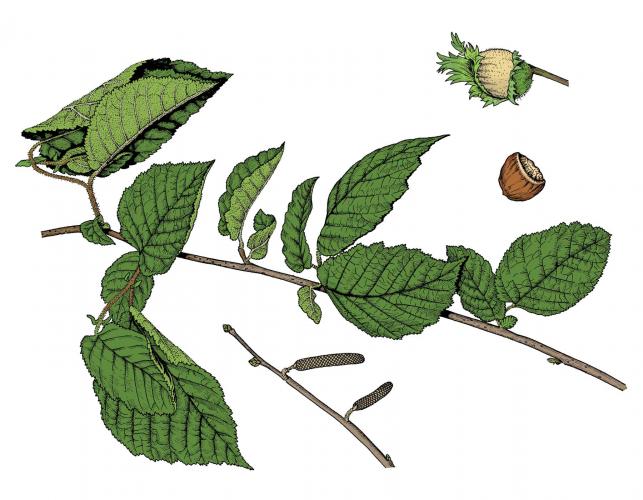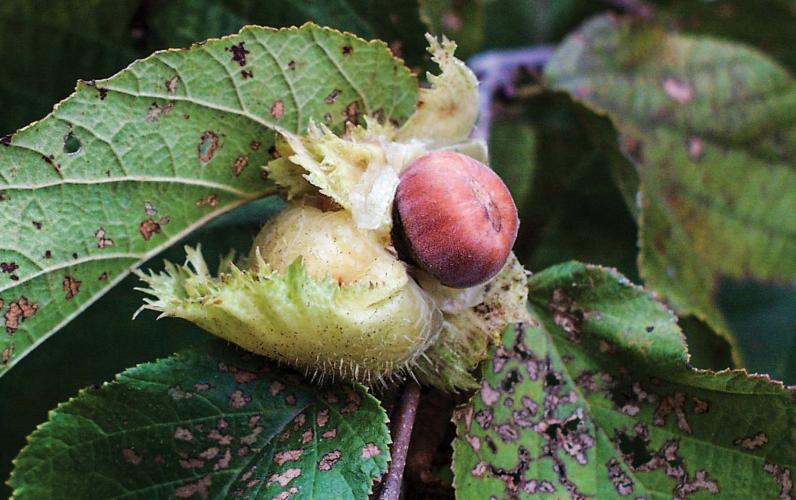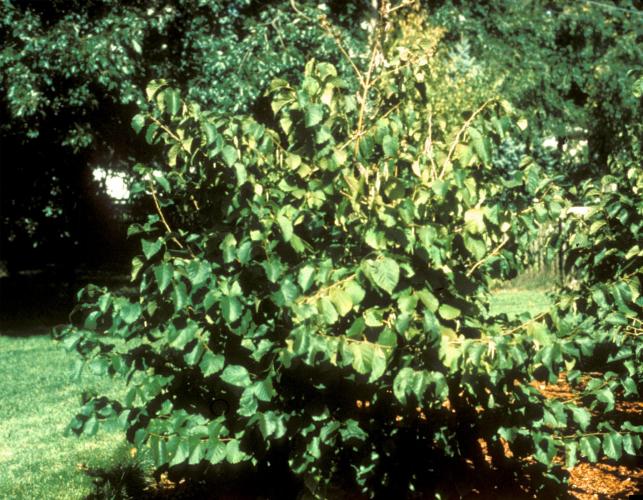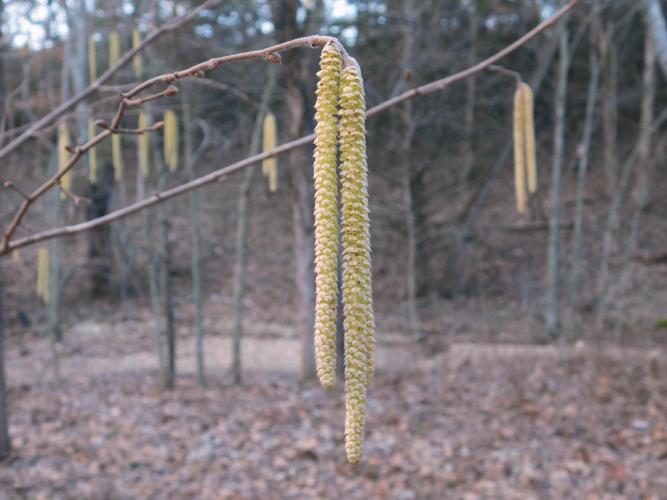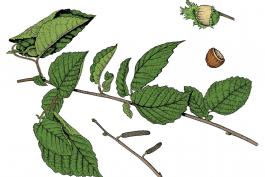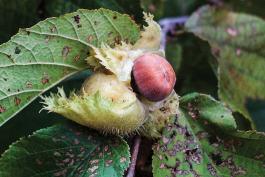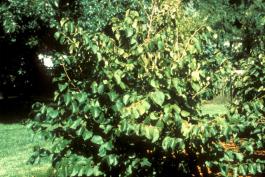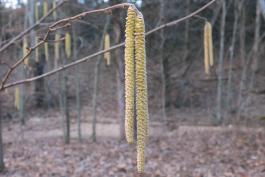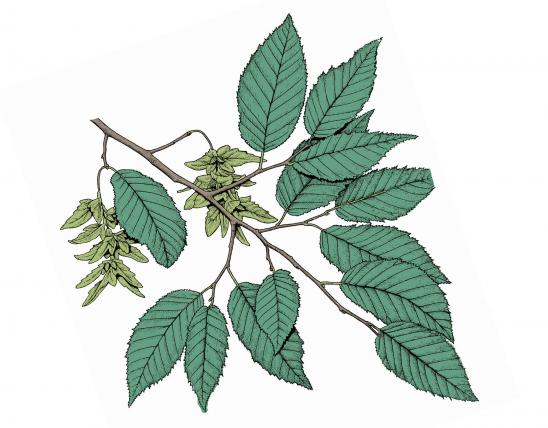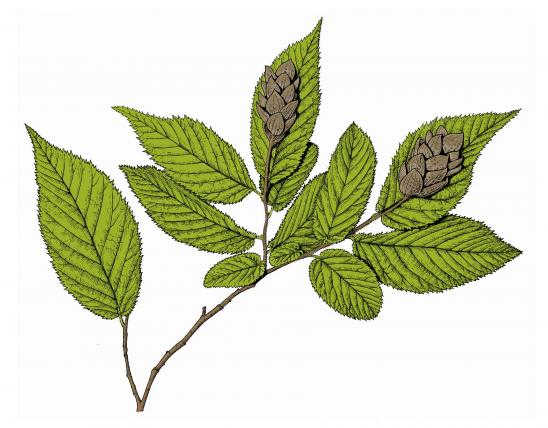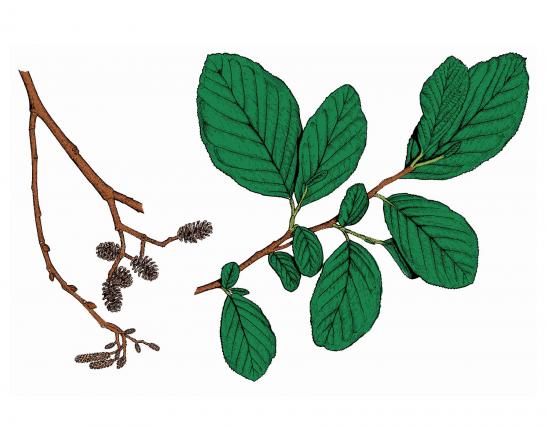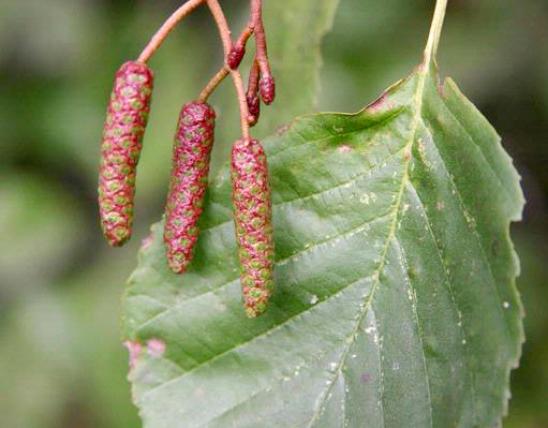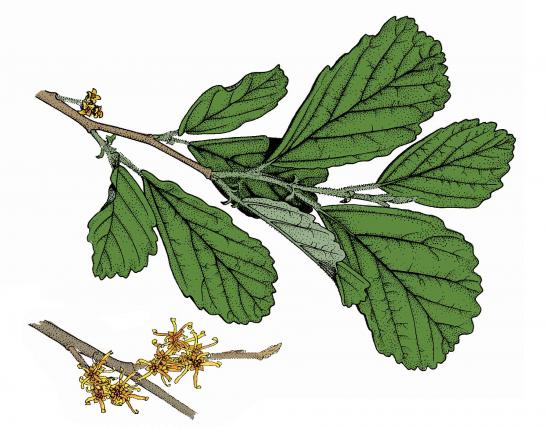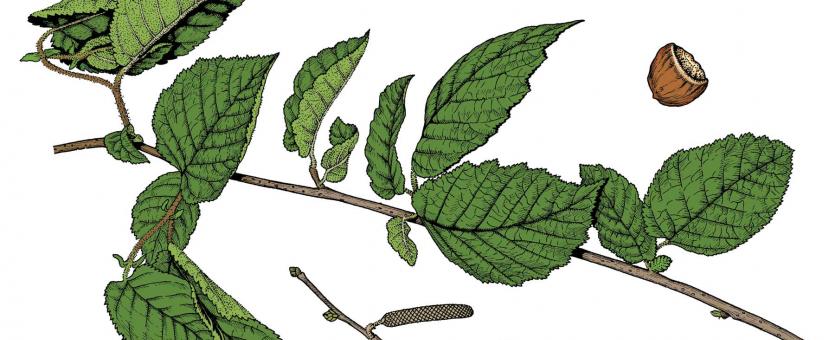
American hazelnut is a thicket-forming, spreading shrub to 10 feet high.
Leaves are simple, alternate, 3–6 inches long, 2–4½ inches wide; egg-shaped to oval, the tip pointed, the base broadly rounded or heart-shaped, the margin finely double-toothed, thin; the upper surface dark green, somewhat rough and smooth or nearly so; the lower surface paler with matted hairs to more or less hairy; leaf blade with 6–9 veins on each side of the central vein, sometimes branched; leaf stalk ¼–1⅛ inch long, often with reddish, gland-tipped hairs, or long white hairs. The leaves can be very colorful in autumn, varying from orange to brick red or purplish red, or with combinations of rose, orange, yellow, and pale green.
Bark is brown to grayish brown, fairly smooth, with the thin outer layer slightly grooved; the wood is nearly white, medium hard, and fine-grained.
Twigs are slender, angled upward, reddish brown at first with long, spreading, usually gland-tipped hairs, gray and smooth later.
Flowers late February–April. Male (staminate) and female (pistillate) flowers are separate but on the same plant. Staminate flowers in catkins (dense, elongated flower clusters); these are mostly solitary, 3½–4 inches long, cylindrical, brown, petals lacking; stamens 4. Pistillate catkins are much shorter, clustered at the ends of short branches on the previous year’s growth (as are the staminate catkins), petals lacking, stigmas red.
Fruits mature July–August. They are nuts, in clusters of 1–3 (sometimes to 5), encased in large bracts (modified leaves). The bracts are more or less flat, unlobed, leafy to paper in texture, completely enclosing the nut and falling with it; each bract is ¾–1¼ inch long, projects far beyond the nut, is strongly veined, more or less felty-hairy, with the outer edge sharply toothed. The nuts are ⅜–⅝ inch long, egg- to globe-shaped, usually wider than long, the shell thick and hard; light brown, sweet, and edible.
Similar species: Other Missouri members of the birch family are in different genera. They include European alder (an introduced species) and common alder (Alnus glutinosa and A. serrulata); river birch (Betula nigra); hornbeam (musclewood) (Carpinus caroliniana); and hop hornbeam (ironwood) (Ostrya virginiana). Of these, common alder is probably most similar to hazel when it comes to leaf shape and texture, but the fruits of alder are quite different, resembling miniature pinecones.
Beaked hazel (Corylus cornuta) is closely related, but it does not occur naturally in Missouri. It grows in states farther northeast and east.
Height: 3–10 feet; spread: 8 feet.
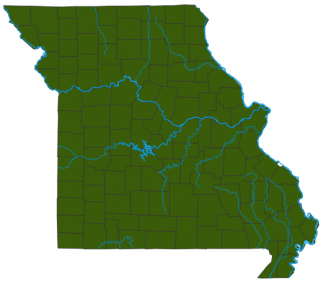
Statewide.
Habitat and Conservation
Occurs in upland prairies, savannas, glades, woodlands and woodland borders, upland forests, bases, ledges, and tops of bluffs, banks of streams and rivers, and margins of ponds and lakes; also in moist or dry thickets along roadsides and railroads.
Before European settlement, large hazel thickets were a common component of Missouri prairies and savannas. Except for a few highly localized examples in northern Missouri, hazel prairies, as they were known, have essentially disappeared from the landscape.
Status
Native shrub bearing edible nuts.
Human Connections
The nuts of American hazelnut have long been prized as a tasty and nutritious food. They are similar to but smaller than the nuts of European hazel or filbert (C. avellana). For many people, they are a favorite wild edible. The nuts are easy to identify, with the unusual, jagged-edged bract that folds around them. The sweet nuts are sold on the market, and they are prized by cooks. There are many ways to prepare them; most people start by roasting or chopping them, or grinding them into a flour. After that, you can use them as you could use any other nut:
- Sprinkled atop fish, vegetables, salads, pastas, soups, yogurts, cereals, or ice cream
- As part of a sautéed or stir-fried dish
- As an ingredient in stuffing
- Ground as part of a pesto sauce, or as a nut butter
- Ground and used to replace some of the flour in breads, muffins, pasta, tortes, unbaked/crumb pie crusts
- Ground into flour and used as a thickener in soups
- Baked into brownies, fruitcakes, cookies, and candy (such as chocolate-nut bark)
Hazelnut has been grown as an ornamental since 1798. In addition to its edible nuts and attractive leaves, it can produce good fall color. It’s a native shrub that tolerates clay soils, nearness to black walnut, attracts birds, and is showy much of the year. It makes a good hedge or screen in informal plantings, where it can spread into a thicket. If you want to grow it as a single plant, make sure to remove the suckers that arise near the base.
American hazelnut is also used for shelter-belt planting, controlling erosion, and as wildlife food and cover.
The genus name, Corylus, is the classical Greek name for the European hazelnut; apparently it came from the word kopus (helmet), in reference to the bract covering the top of the nut.
Ecosystem Connections
Among the many animals that eat the nuts are bobwhite, ruffed grouse, blue jays, squirrels, and white-tailed deer. Squirrels and other small mammals will take the nuts as soon as they loosen from the bracts.
Hazelnut catkins provide important winter food for ruffed grouse and white-tailed deer, which also browse on the twigs.
A variety of insects make a living from American hazelnut, chomping the leaves or sucking the sap: aphids, leafhoppers, lace bugs, stinkbugs, walkingsticks, leaf beetles, and the caterpillars of several butterfly and moth species. Larval weevils may eat the nuts or other parts of the plant. Juvenal’s duskywing, a type of skipper, is one butterfly associated with American hazel. The spectacular Polyphemus moth uses a variety of larval host plants, but hazel is one of its favorites. The luna moth is another moth whose caterpillars eat hazel leaves, plus there are several noctuid and pyralid moths as well. The filbert worm — the larva of a type of tortricid moth — eats the nutmeats of hazel, acorns, beech, chestnut, and pecan.
Thickets of American hazelnut, with its dense-branching habit and sturdy leaves, are great cover for wild animals and provide a safe place for songbirds to build their nests.
